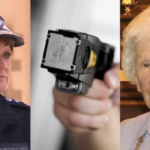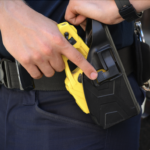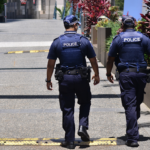NSW Police Taser 95-Year Old Woman in Nursing Home

An elderly New South Wales woman is fighting for her life in hospital after being tasered by police officers at a nursing home, causing her to fracture her skull as she hit the floor.
Investigations into the actions of NSW Police are continuing. However, it has been reported that the woman is a dementia patient at a nursing home in Cooma.
Reports state she was wandering around the facility in the early hours of the morning, then as she stood at her walking frame, staff noticed she was holding a knife.
Nursing home staff called police, who allegedly tasered the woman twice – once in her back and once in her chest. She collapsed, hit her head and suffered a fractured skull and a brain bleed. She is now being closely monitored at Cooma Hospital.
In an initial statement, NSW Police said “an elderly woman sustained injuries during an interaction with police at an aged care facility” and that a critical incident team would investigate, with the investigation subject to independent review.
More questions than answers
There are so many questions to be answered, such as why the nursing home staff didn’t have appropriate training and techniques to disarm the woman who was in their care, in a facility which has the purpose of caring for elderly people who can no longer look after themselves in their own home, as well as, what kind of knife the woman was holding, and whether or not she actually posed a real and serious threat to staff, residents and police officers.
It’s also again raised important issues around the fact that police officers are not specifically trained to deal with people who have mental health conditions, and yet they are often the first responders when someone is triggered and suffering or experiencing a mental health episode.
Tasers can be deadly
Further, there’s the issue of tasers. In a review released in February by the Law Enforcement Conduct Commission which examined 210 incidents involving use of force by NSW police officers between May 2020 and May 2021, tasers were used during 16 incidents.
Statistics published in 2019 reported that NSW Police drew their tasers almost 3000 times in the course of duty over the previous five years, and in more than 1000 of those cases, officers logged a mental health issue, meaning they reported the person they tasered as not being in full control of themselves.
In recent years in the US and Canada police have been told not to use tasers on a person’s chest and upper body, but to rather aim for the abdomen, lower back or legs. These directives have been issued as a result of concerns about the increasing links between tasers and cardiac arrest.
It’s not certain whether the elderly woman will survive given the seriousness of her injuries.
The internal investigation will hopefully provide answers, and hopefully there will be police worn body camera footage to draw conclusions from.
Internal investigation underway
While investigations are continuing, it’s important to remain open-minded – indeed, people suffering dementia are not harmless when armed with a sharp implement, and the nature of dementia means they can most definitely be unpredictable.
However, the the fact of the matter is that it will be very difficult for the New South Wales Police Force to convince the wider community that the only appropriate response available to officers in the moment was to deploy tasers twice, on a frail and elderly person, particularly in the context of regular instances of disproportionate use of force across all police forces in Australia, which appears to run parallel to the incremental increase in weapons carried by officers in the general course of their duties, including tasers and capsicum spray.
While tasers and capsicum (pepper) spray are classified as a ’non-lethal’ there have been numerous recorded incidents in recent years, where both have resulted in fatalities.
In recent years in Canada and the US, police have been directed to only use tasers when they are aimed at a person’s back, abdomen or legs, because there is increasing evidence linking tasering a person in the chest to cardiac arrest.
Staff followed procedure
The Snowy Monaro Regional Council runs the facility where the incident occurred and it has defended the nurses and carers on duty at the time of the incident, saying they followed procedures and did what was needed in the circumstances. These staff have a duty of care to approximately 40 other residents at the facility.
The Aged Care Quality and Safety Commission will also receive an incident report.







